Important Notes for NEET: Cell- The Unit of Life- 2 PDF Download
The Endomembrane system is a important component within eukaryotic cells, serving as a complex network of membranes and organelles that work together to perform various essential functions. It includes a range of organelles like the endoplasmic reticulum (ER), Golgi apparatus, lysosomes, and vacuoles. These organelles are interconnected by membranes and function together to carry out tasks such as protein synthesis, modification, and transport, lipid metabolism, and cellular waste management.
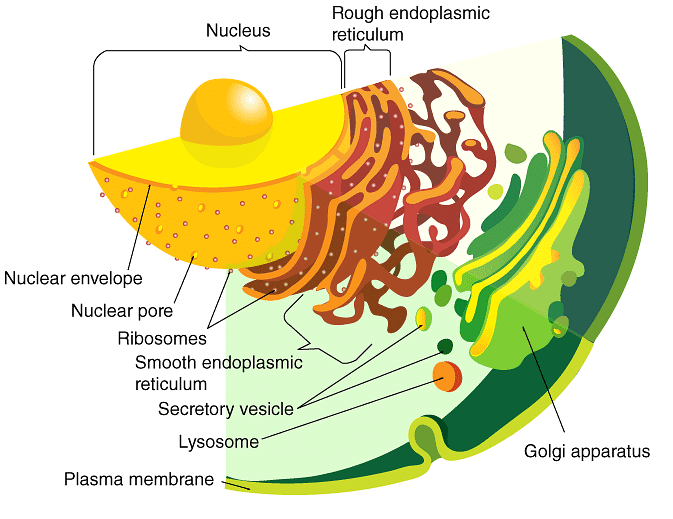 The Endomembrane System
The Endomembrane System
The endomembrane system encompasses organelles such as the endoplasmic reticulum (ER), Golgi complex, lysosomes, and vacuoles. These organelles work together to perform specific tasks.
Note: The mitochondria, chloroplasts, and peroxisomes do not operate in coordination with the components of the endomembrane system. Therefore, they are not classified as part of this system.
Let's study these organelles in detail:
1. Endoplasmic Reticulum
Electron microscopy studies conducted on eukaryotic cells reveal the presence of a network or reticulum made up of small tubular structures scattered throughout the cytoplasm. This network is known as the endoplasmic reticulum (ER).
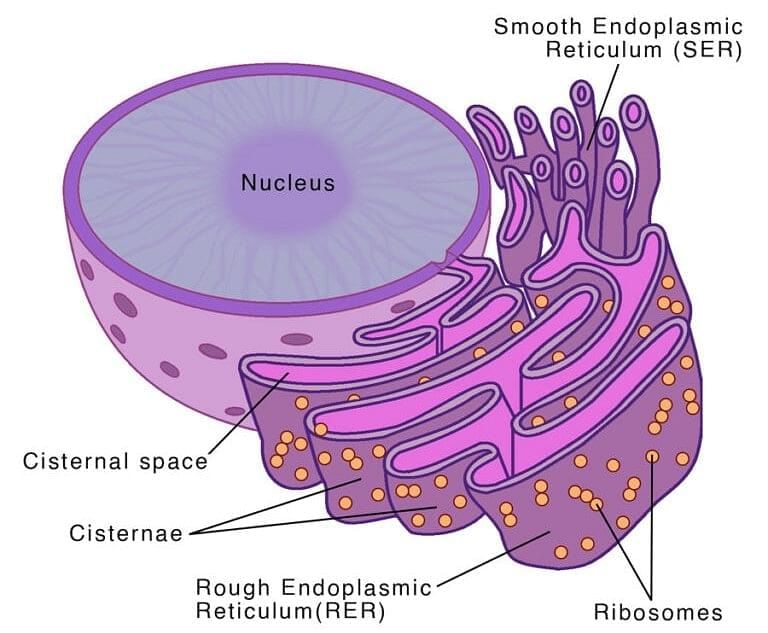 Endoplasmic Reticulum
Endoplasmic Reticulum
The ER often shows ribosomes attached to their outer surface. The endoplasmic reticulum bearing ribosomes on their surface is called rough endoplasmic reticulum (RER). In the absence of ribosomes they appear smooth and are called smooth endoplasmic reticulum (SER).
- Rough endoplasmic reticulum: RER is frequently observed in cells actively engaged in protein synthesis and secretion. It is extensive and maintains a continuous connection with the outer membrane of the nucleus.
- Smooth endoplasmic reticulum: SER primarily responsible for lipid synthesis. In animal cells, SER is involved in the synthesis of lipid-like steroidal hormones.
2. Golgi apparatus
Camillo Golgi discovered reticular structures near the nucleus in 1898, and these structures were later named Golgi bodies after him. Golgi bodies consist of flat, disk-shaped sacs or cisternae, typically measuring 0.5µm to 1.0µm in diameter.
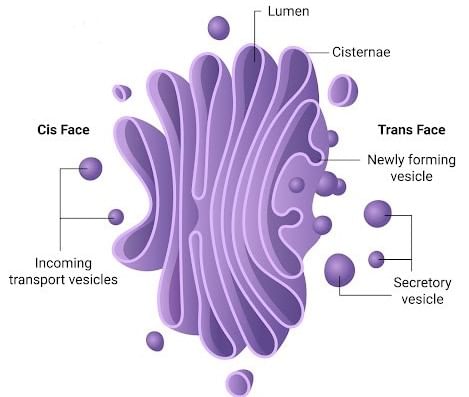 Golgi Apparatus
Golgi Apparatus
These cisternae are stacked parallel to each other and can vary in number within a Golgi complex. Golgi cisternae are arranged concentrically near the nucleus, featuring a distinct convex cis face and a concave trans face. Despite their differences, the cis and trans faces of the Golgi apparatus are interconnected.
Functions:
- The primary function of the Golgi apparatus is to package materials, which can be directed either to intracellular destinations or secreted outside the cell.
- Materials to be packaged, in the form of vesicles from the endoplasmic reticulum (ER), merge with the cis face of the Golgi apparatus and move toward the maturing face.
- The Golgi apparatus remains closely associated with the endoplasmic reticulum due to this process.
- Many proteins synthesized by ribosomes on the endoplasmic reticulum undergo modifications within the Golgi cisternae before being released from its trans face.
- The Golgi apparatus plays a crucial role in the formation of glycoproteins and glycolipids.
3. Lysosomes
Lysosomes are vesicular structures enclosed by membranes, and they are created through the packaging process in the Golgi apparatus. These isolated lysosomal vesicles have been discovered to contain a wide range of hydrolytic enzymes (known as hydrolases), including lipases, proteases, and carbohydrases.
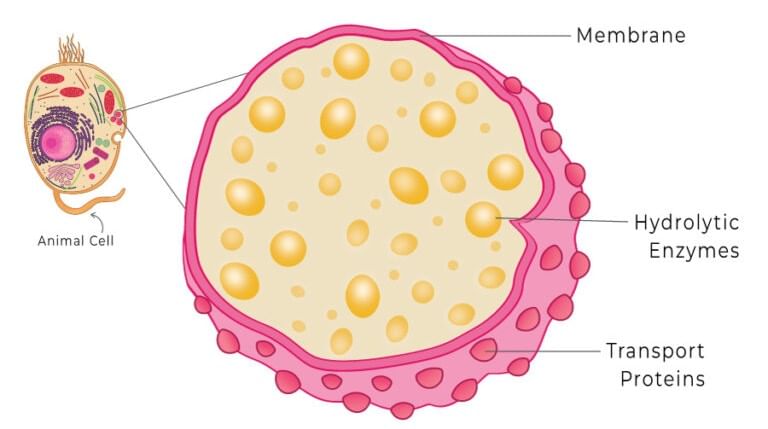 Lysosomes
Lysosomes
Function: These enzymes are most effective when the environment is acidic. They have the capacity to break down carbohydrates, proteins, lipids, and nucleic acids.
4. Vacuoles
Vacuoles are membrane-bound compartments present in the cytoplasm of cells. They contain water, sap, waste products, and other substances that aren't essential for the cell's functioning. A single membrane known as the tonoplast encloses the vacuole. In plant cells, vacuoles can occupy a significant portion, up to 90 percent, of the cell's volume.
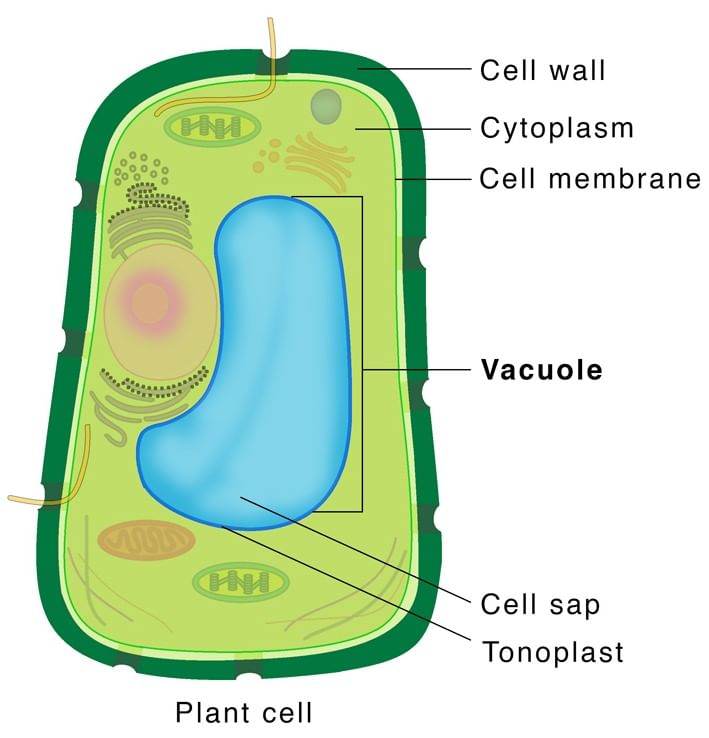 Vacuole - Plant Cell
Vacuole - Plant Cell
Function:
- In plant cells, the tonoplast plays a crucial role in transporting various ions and substances into the vacuole against concentration gradients. As a result, these substances are found in much higher concentrations within the vacuole compared to the cytoplasm.
- In organisms like Amoeba, the contractile vacuole is important for regulating osmotic balance and eliminating waste. Additionally, in many cells, such as those in protists, food vacuoles are formed when food particles are engulfed by the cell.
5. Mitochondria
Mitochondria are semi autonomous having hollow sac like structures present in all eukaryotes except mature RBCs of mammals and sieve tubes of phloem. These are absent in all prokaryotes like bacteria and cyanobacteria. Mitochondria are organelles found in the cells that produce energy. They are not easily visible under the microscope and the number of mitochondria per cell varies depending on the cells' physiological activity.
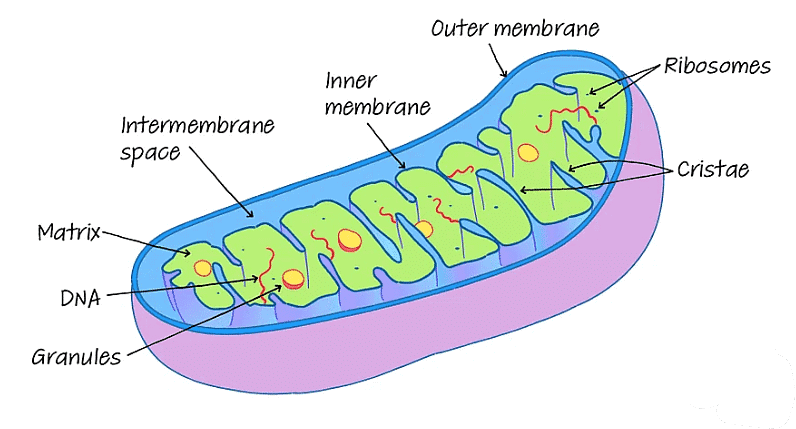 Mitochondria
Mitochondria
- Mitochondria have a considerable degree of variability in shape and size. They are typically sausage-shaped or cylindrical in shape and are double membrane-bound structures.
- The outer membrane forms the continuous limiting boundary of the organelle, while the inner membrane divides the lumen into two aqueous compartments: the outer compartment and the inner compartment.
- The inner compartment is filled with a dense homogeneous substance called the matrix. The inner membrane also forms a number of infoldings called cristae that increase the surface area.
- Mitochondrial Division: Mitochondria divides by fission.
Functions of Mitochondria:
- Mitochondria are the sites of aerobic respiration and produce cellular energy in the form of ATP.
- They have their own specific enzymes associated with mitochondrial function.
- Additionally, the matrix of the mitochondria contains a single circular DNA molecule, a few RNA molecules, ribosomes (70S) and the components required for the synthesis of proteins.
6. Plastids
Plastids are present in all plant cells and in euglenoides, and they are easily visible under a microscope because of their substantial size. They contain distinct pigments that give plants specific colors. Plastids can be categorized into three types—chloroplasts, chromoplasts, and leucoplasts—based on the specific pigments they contain.
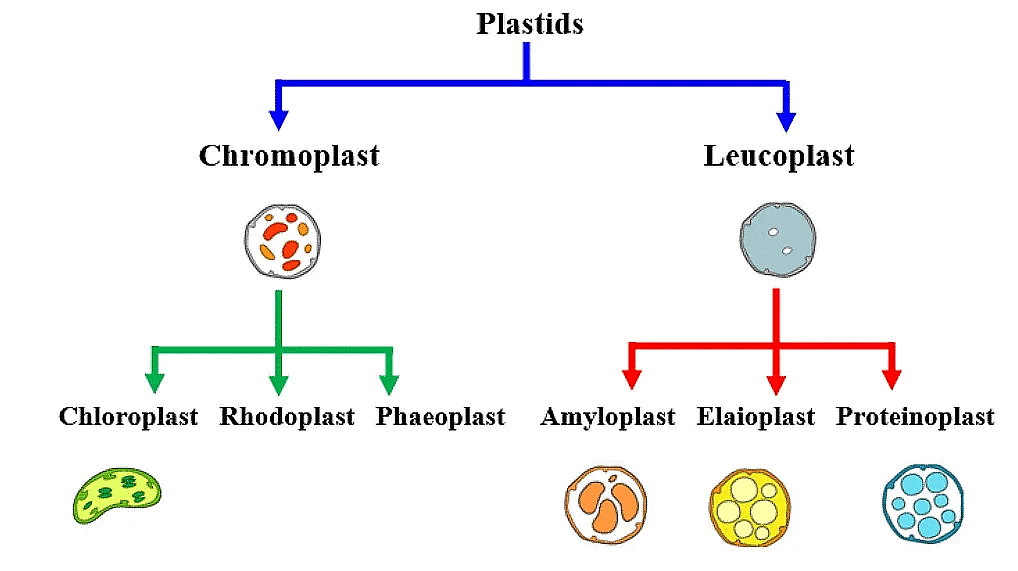 Types of Plastids
Types of Plastids
(a) Chloroplasts
Chloroplasts play a vital role in capturing light energy for the process of photosynthesis, utilizing pigments like chlorophyll and carotenoids. They are organelles enclosed by a double membrane. Notably, the inner membrane of chloroplasts has relatively low permeability.
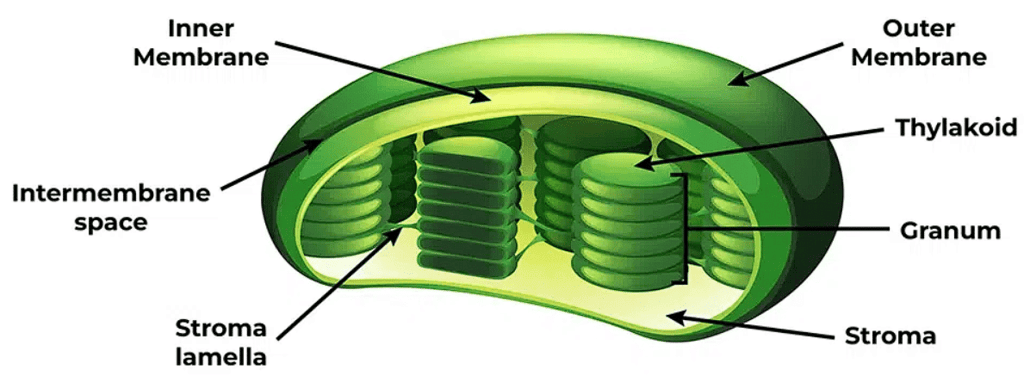 Chloroplast
Chloroplast
- Within the chloroplast, there is an inner space delimited by the inner membrane. This space contains flattened membranous sacs known as thylakoids, which house the chlorophyll necessary for photosynthesis.
- Thylakoids are organized into stacks called grana and are interconnected by flat membranous tubules known as stroma lamellae. The lumen is the space enclosed by the thylakoid membrane.
- The stroma, another part of the chloroplast, contains enzymes essential for synthesizing carbohydrates and proteins. Additionally, it houses circular DNA molecules and ribosomes. Chlorophyll pigments are concentrated within the thylakoids, and it's worth noting that the ribosomes found in chloroplasts are smaller (70S) compared to those in the cytoplasm (80S).
(b) Chromoplasts: Chromoplasts contain fat-soluble carotenoid pigments such as carotene, xanthophylls, and others. These pigments give the plant parts a yellow, orange or red colour.
(c) Leucoplasts: Leucoplasts are colourless plastids of varied shapes and sizes that store nutrients. There are three types of leucoplasts:
(i) Amyloplasts store carbohydrates (starch), e.g., potato
(ii) Elaioplasts store oils and fats
(iii) Aleuroplasts store proteins
7. Ribosomes
Ribosomes were initially observed as dense particles under the electron microscope by George Palade in 1953. They consist of ribonucleic acid (RNA) and proteins and are not enclosed by any membrane. Ribosomes are tiny structures made up of ribonucleic acid (RNA) and proteins.
 Ribosomes
Ribosomes
Eukaryotic ribosomes have a sedimentation coefficient of 80S, while prokaryotic ribosomes have a sedimentation coefficient of 70S. Each ribosome is composed of two subunits: a larger subunit and a smaller subunit.
- In 80S ribosomes, the two subunits are 60S and 40S, while in 70S ribosomes, they are 50S and 30S. The "S" in these values represents the sedimentation coefficient, which indirectly indicates the ribosome's density and size.
- It's important to note that both 70S and 80S ribosomes consist of two subunits.
- Ribosomes are tiny structures made up of ribonucleic acid (RNA) and proteins.
8. Cytoskeleton
The cytoskeleton is a complex system of proteinaceous filamentous structures, including microtubules, microfilaments, and intermediate filaments, found within the cytoplasm.
Cytoskeleton
Collectively, these components are known as the cytoskeleton, and they serve various essential roles within the cell. These functions encompass providing mechanical support, enabling cell motility, and maintaining the cell's shape.
9. Cilia and Flagella
Cilia (singular: cilium) and flagella (singular: flagellum) are slender, hair-like projections extending from the cell membrane. Cilia are relatively small structures that function like oars, generating movement in either the cell or the surrounding fluid. Flagella, on the other hand, are longer and primarily responsible for propelling the cell. It's worth noting that prokaryotic bacteria also possess flagella, but their structure differs from that of eukaryotic flagella.
 Cillia and Flagella
Cillia and Flagella
Under the electron microscopic study of cilia and flagella show that:
- They are covered with plasma membrane
- Their core, called the axoneme, consists of microtubules running parallel to the long axis
- The axoneme usually has nine doublets of radially arranged peripheral microtubules, and a pair of centrally located microtubules
- This arrangement of axonemal microtubules is referred to as the 9+2 array
- The central tubules are connected by bridges and enclosed by a central sheath, which is connected to one of the tubules of each peripheral doublet by a radial spoke
- There are nine radial spokes
- The peripheral doublets are also interconnected by linkers
10. Centrosome and Centrioles
The centrosome is an organelle typically composed of two cylindrical structures known as centrioles, surrounded by a less structured pericentriolar material. Within the centrosome, both centrioles are oriented perpendicular to each other and exhibit an organization resembling a cartwheel.
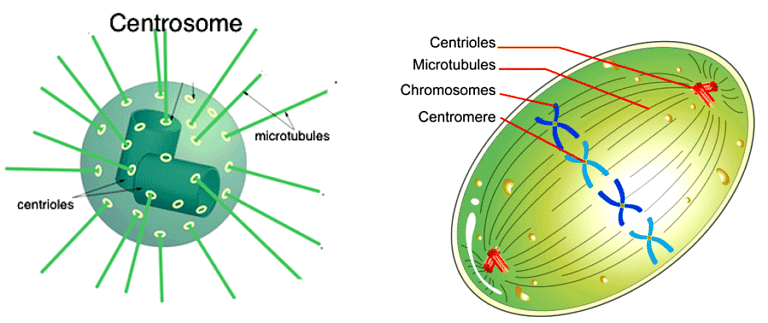 Centrosome and Centrioles
Centrosome and Centrioles
- These centrioles consist of nine evenly spaced peripheral fibrils made of tubulin protein, with each peripheral fibril being a triplet.
- These adjacent triplets are interconnected. The central portion of the proximal region of the centriole is also proteinaceous and is referred to as the hub. It is linked to the tubules of the peripheral triplets by radial spokes composed of protein.
- Centrioles play essential roles, such as serving as the basal body for cilia or flagella and forming spindle fibers that give rise to the spindle apparatus during cell division in animal cells.
11. Nucleus
The concept of the nucleus as a cellular organelle was first introduced by Robert Brown back in 1831. Later on, Flemming coined the term "chromatin" to describe the material within the nucleus that could be stained with basic dyes.
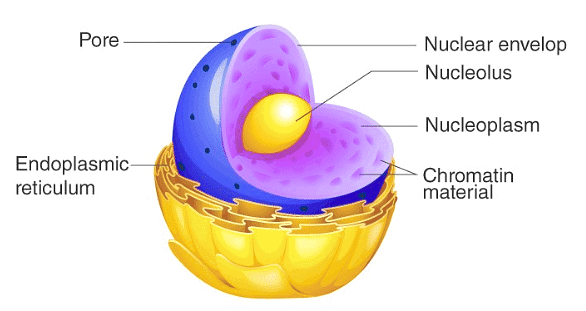 Nucleus
Nucleus
- During the interphase, which is the phase when a cell is not actively dividing, the nucleus displays a complex structure. It contains highly extended and intricate nucleoprotein fibers known as chromatin, a nuclear matrix, and one or more spherical bodies called nucleoli.
- Typically, the outer membrane of the nuclear envelope remains continuous with the endoplasmic reticulum and is also studded with ribosomes.
- The nuclear envelope features small pores at various locations, formed by the fusion of its two membranes. These nuclear pores serve as passages through which RNA and protein molecules can move bidirectionally between the nucleus and the cytoplasm.
Chromosomes
Chromosomes are thread-like structures found in the nucleus of eukaryotic cells, such as those in humans and many other organisms. They are made up of DNA, which contains the genetic information or genes that carry instructions for various cellular functions and traits.
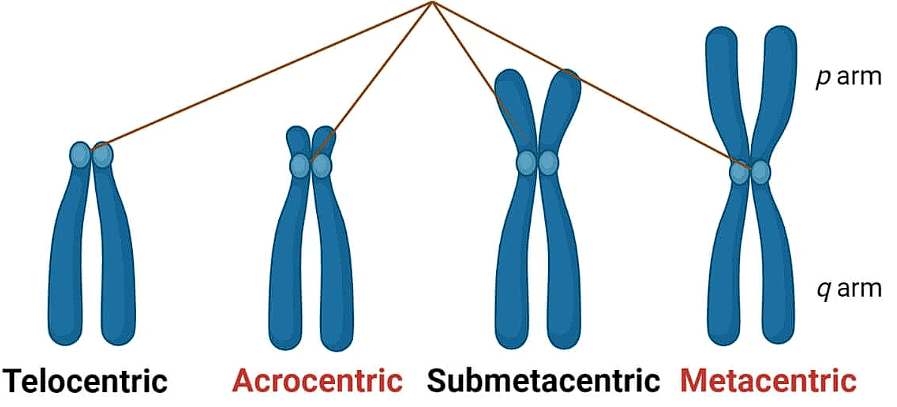 Types of Chromosome
Types of Chromosome
- Chromosomes are essential for the process of cell division, as they help ensure that genetic information is accurately passed from one generation of cells to the next during processes like mitosis and meiosis.
- In humans, the normal number of chromosomes in a cell is 46 (23 pairs), and alterations in the structure or number of chromosomes can lead to genetic disorders.
12. Microbodies
Microbodies are small, membrane-bound vesicles found in both plant and animal cells. These microbodies are notable for containing a variety of enzymes within their structure. These enzymes are involved in diverse cellular processes and metabolic reactions. Microbodies are essential for compartmentalizing specific enzymatic activities, allowing cells to carry out various biochemical reactions efficiently and independently within these specialized vesicles.














